|
In 1906, two prospectors got lost in
rare Death Valley fog while enroot to Harrisburg. They stumbled
across gold-bearing ledges. The town of Skidoo formed around
this area and in 1906 the Skidoo post office was opened. By 1907
Skidoo had more that 500 residents. By 1917 one mine is reported
to have produced 1.5 million in gold. Today no structures remain,
only a few fallen buildings and the ruins of the stamp mill as
well as a few graves. Courtesy Stanley Paher.
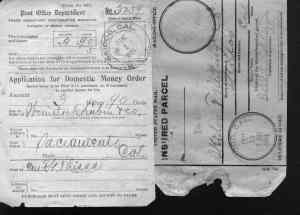
Application for money order in the name of Mrs. F.G. Thisse of
Skidoo. Her husband, Frank G. Thisse, was the Justice of the
Peace in Skidoo for many years.
David A. Wright collection.

Meal ticket for Skidoo Mines Co.
David A. Wright collection.
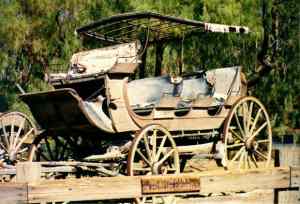
The Rhyolite to Skidoo stage. Probably that of Kimball Brothers
of Rhyolite, who ran stage lines to many Death Valley area locations.
On display at Furnace Creek, California.
Courtesy David A. Wright
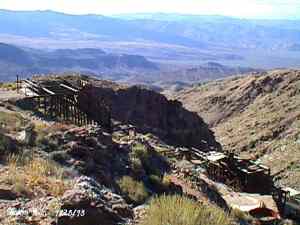
The Skidoo Mill ruins. Sept. 28, 1998.
Courtesy David A. Wright
Great Basin Research
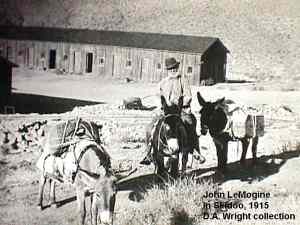
John LeMoigne, a Death Valley area prospector, with his burros in
Skidoo in 1915, during the camp's dying days. David A. Wright collection.
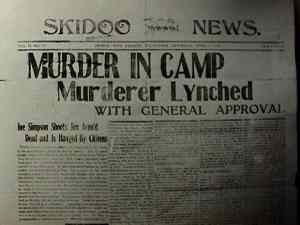
Copy of the April 25, 1908 SKIDOO NEWS with headlines screaming out
the approved lynching of Joe Simpson.
Courtesy David A. Wright Collection
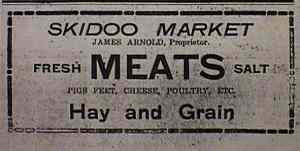
From SKIDOO NEWS, February 1, 1907. From D.A. Wright collection
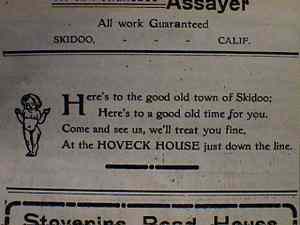
From SKIDOO NEWS, February 1, 1907. From D.A. Wright collection
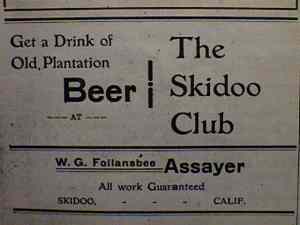
From SKIDOO NEWS, February 1, 1907. From D.A. Wright collection
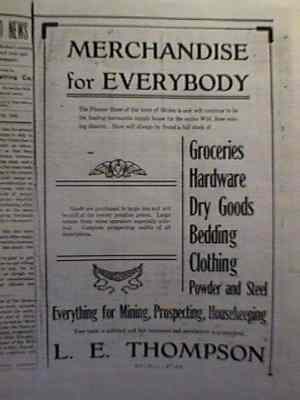
From SKIDOO NEWS, February 1, 1907. From D.A. Wright collection
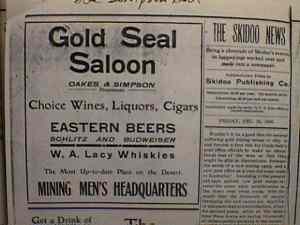
From SKIDOO NEWS, February 1, 1907. From D.A. Wright collection

From SKIDOO NEWS, February 1, 1907. From D.A. Wright collection
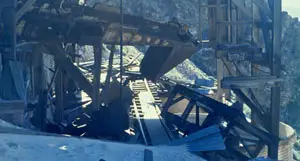
Skidoo Mill Gear
Courtesy Bill Cook
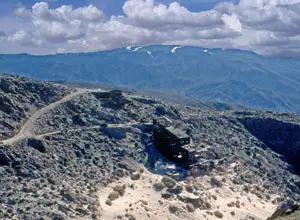
Skidoo Mill
Courtesy Bill Cook
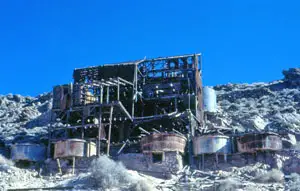
Skioo Mill Leaching Tanks
Courtesy Bill Cook

Skidoo Shadows
Courtesy Bill Cook
_1960-04-18_Skidoo_Mine.jpg)
Location of pictures to the right
Courtesy
Kevin Larson
_Skidoo_Google_Maps.jpg)
Location of pictures to the right
Courtesy
Kevin Larson
|
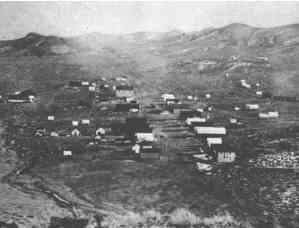
The town of Skidoo. Courtesy Stanley Paher.

Line shack of the Skidoo water pipeline, located about 10 south
of Skidoo in Nemo Canyon. Sept. 28, 1998.
Courtesy David A. Wright
Great Basin Research
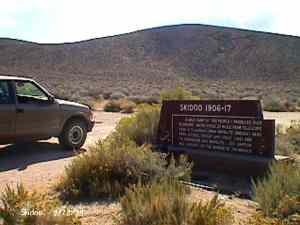
Skidoo townsite. There is virtually nothing left larger than
a 1-gallon tin can left in the townsite of Skidoo. Sept. 28,
1998.
Courtesy David A. Wright
Great Basin Research
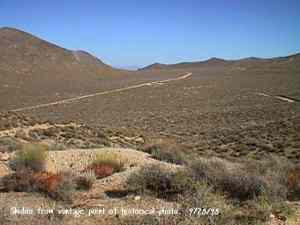
View east over townsite. Even the street grid of town has been
covered in sagebrush. When I visited the townsite last in 1990,
the grid of streets could still be faintly seen. Compare this
scene with that historical photo courtesy of Stan Paher on this
same page. View taken Sept. 28, 1998.
Courtesy David A. Wright
Great Basin Research
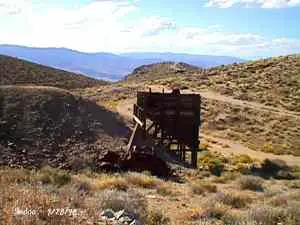
Immediately west of the Skidoo townsite is the mining area, littered with
hazardous mines and shafts. Sept. 28, 1998.
Courtesy David A. Wright
Great Basin Research

Joe Simpson, who was the victim of California's last lynching. Simpson
was a co-owner of the Gold Seal Saloon in Skidoo, who also was heavily
involved in area mining scene. Simpson murdered Jim Arnold, Skidoo's leading
citizen, during a drunken rage. Three days later, on April 22, 1908, Simpson
died at the hand of persons unknown by "strangulation" by a "rope with
a slip knot on." [Quotations from Inyo County death certificate]. Legend
says that due to visiting press reporters from Los Angeles, Simpson was
dug up two days later and this photo taken for benefit of Los Angeles
newspapers. However, research has shown that this photo was taken by Dr.
McDonald, a physician in employ of the Skidoo Mines Company, who exhumed
Simpson to conduct an autopsy so as to inspect the effects that syphilis
has on the brain (Simpson was known to have the disease due to his love
of the red light districts). McDonald took this photo of Simpson strung
up from the cross beam of a tent, then beheaded Simpson, opened the skull
and inspected the brain. He then boiled the flesh off the skull, set the
remains on an ant pile for several days, then kept the skull as a curiosity.
The skull eventually ended up in nearby Trona as a doctors office decoration
for years, then ended up in a private collection; where it still is to
this day.
Courtesy David A. Wright Collection
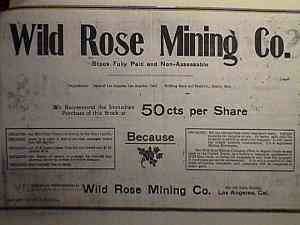
From SKIDOO NEWS, February 1, 1907. From D.A. Wright collection
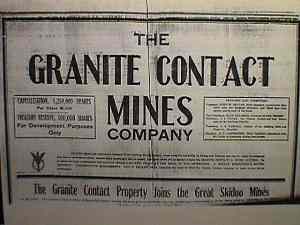
From SKIDOO NEWS, February 1, 1907. From D.A. Wright collection
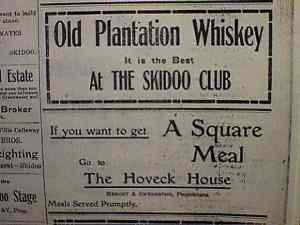
From SKIDOO NEWS, February 1, 1907. From D.A. Wright collection
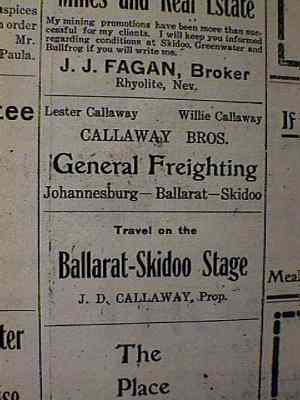
From SKIDOO NEWS, February 1, 1907. From D.A. Wright collection
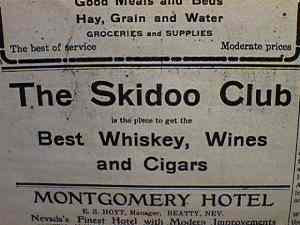
From SKIDOO NEWS, February 1, 1907. From D.A. Wright collection
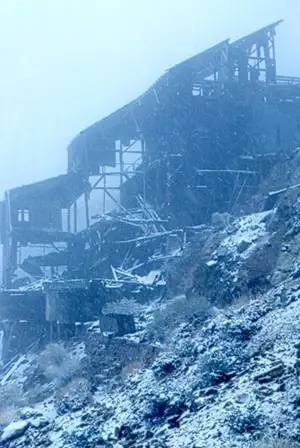
Skidoo in the snow
Courtesy Bill Cook
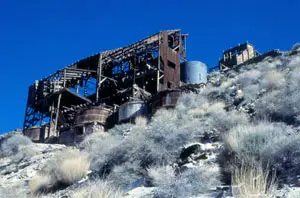
Skidoo Stamp Mill
Courtesy Bill Cook
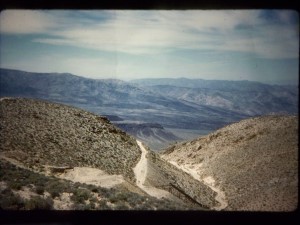
Skidoo 1960
Courtesy
George R. Larson
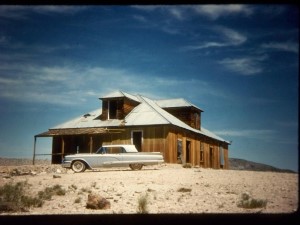
Skidoo 1960
Courtesy
George R. Larson
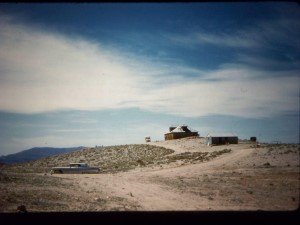
Skidoo 1960
Courtesy
George R. Larson
|


